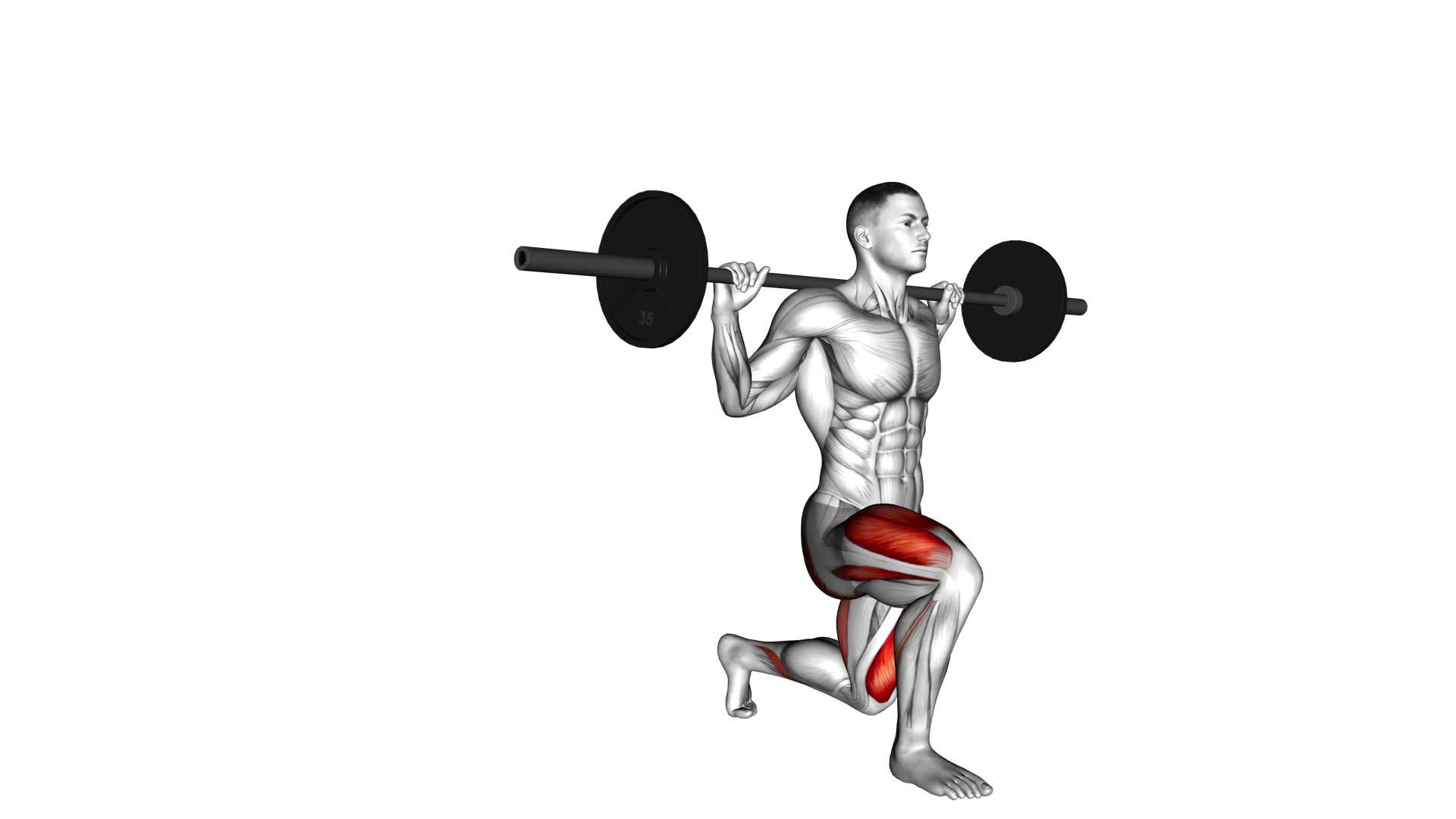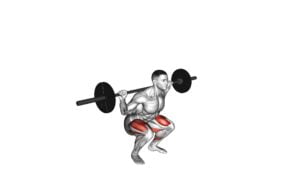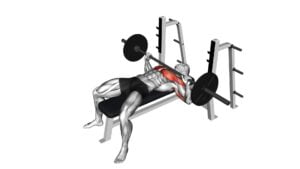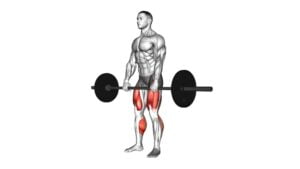Barbell Pause Lunge – Video Exercise Guide & Tips

Get ready to level up your leg workout with the Barbell Pause Lunge!
Watch This Exercise Video
This exercise is perfect for targeting your quads, hamstrings, and glutes.
By incorporating a pause at the bottom of the lunge, you'll engage your muscles even more, increasing your strength and stability.
In this article, you'll find a video exercise guide and helpful tips to ensure you perform the Barbell Pause Lunge with proper form and technique.
So grab a barbell and get ready to feel the burn!
Key Takeaways
- Targets quads, hamstrings, and glutes
- Increases strength and stability
- Can be modified for different fitness levels
- Helps prevent injuries
Benefits of the Barbell Pause Lunge
By incorporating the Barbell Pause Lunge into your workout routine, you can maximize the benefits of this exercise.
Lunges are a great way to target multiple muscle groups, including your quadriceps, glutes, and hamstrings. They also help improve your balance and stability. Adding a barbell and a pause to your lunges takes the exercise to the next level.
One of the main benefits of incorporating lunges into your workout routine is that they're a functional movement. This means they mimic movements you do in everyday life, like walking or climbing stairs. By strengthening the muscles used in these movements, you can improve your overall functionality and prevent injuries.
The Barbell Pause Lunge can be modified to suit different fitness levels. Beginners can start by using just their body weight or holding onto a stable object for support. As you become more comfortable and stronger, you can gradually add weights, such as dumbbells or a barbell, to increase the challenge. The pause at the bottom of the lunge helps improve stability and control.
Proper Form and Technique
To perform the Barbell Pause Lunge with proper form and technique, you need to focus on maintaining a stable and controlled movement throughout the exercise. Here are some key points to keep in mind:
- Maintain a neutral spine: Keep your back straight and core engaged throughout the movement. Avoid rounding or arching your back, as this can lead to injury.
- Step forward with control: Take a big step forward, ensuring that your knee stays directly above your ankle. Lower your body until your front thigh is parallel to the ground, and pause for a moment before pushing back up.
- Keep your balance: It's important to distribute your weight evenly between your front and back legs. This will help you stay stable and prevent you from leaning too far forward or backward.
Now that you know how to perform the Barbell Pause Lunge with proper form, let's address some common errors and modifications. One common mistake is allowing your knee to cave inwards during the lunge. To prevent this, focus on pushing your knee outwards as you lower your body. If you're new to this exercise or have limited mobility, you can start by performing the lunge without any weights or using a lighter load.
With a solid understanding of the proper form and technique, you're ready to explore variations and progressions of the Barbell Pause Lunge.
Variations and Progressions
Explore different variations and progressions of the Barbell Pause Lunge to challenge your muscles and continue making gains.
As you become more advanced, you can incorporate weights to increase the intensity of the exercise. One way to do this is by holding a dumbbell in each hand, resting them on your shoulders. This adds resistance and forces your muscles to work harder.
Another option is to use a barbell instead of dumbbells. Place the barbell across your upper back and hold it securely with both hands. This variation not only challenges your muscles but also helps improve your balance and stability.
To further progress the exercise, you can try performing the Barbell Pause Lunge on an unstable surface, such as a BOSU ball or a balance board. This will engage more muscles for stability and core strength.
Remember to start with lighter weights and gradually increase as you get stronger. Incorporating these advanced modifications will help you take your Barbell Pause Lunge to the next level and continue seeing progress in your fitness journey.
Common Mistakes to Avoid
Avoid rushing through the Barbell Pause Lunge, as this can lead to poor form and potential injury. Take your time and focus on maintaining proper technique. Here are some common mistakes to avoid:
- Leaning too far forward: Keep your torso upright throughout the movement to avoid putting excessive strain on your lower back. Engage your core to help maintain balance and stability.
- Not stepping far enough: Make sure to take a big enough step forward so that your front knee is directly above your ankle when you lower into the lunge. This will help to prevent knee pain and ensure proper alignment.
- Neglecting to pause: Remember to pause briefly at the bottom of the lunge, with your back knee hovering just above the ground. This pause helps to activate the muscles in your legs and glutes, promoting strength and stability.
By avoiding these common mistakes, you can maximize the benefits of the Barbell Pause Lunge while reducing the risk of injury. Focus on maintaining balance, keeping your form in check, and pausing to engage your muscles.
Happy lunging!
Tips for Maximizing Results
To maximize your results with the Barbell Pause Lunge, focus on maintaining proper form, engaging your muscles, and challenging yourself with increasing weights. In addition to these key aspects, there are a few tips to keep in mind that can further enhance your progress.
Firstly, nutrition plays a crucial role in maximizing your results. Make sure to fuel your body with a well-balanced diet that includes lean proteins, complex carbohydrates, and healthy fats. Prioritize nutrient-dense foods to provide your muscles with the necessary fuel for growth and recovery. Stay hydrated by drinking plenty of water throughout the day, as proper hydration is essential for optimal performance.
Secondly, injury prevention should be a top priority. Before starting any exercise, warm up properly to prepare your muscles for the workout ahead. Incorporate dynamic stretches and mobility exercises to increase your range of motion and reduce the risk of injury. Listen to your body and avoid pushing yourself too hard, as overexertion can lead to injuries. If you experience any pain or discomfort during the exercise, stop immediately and consult a healthcare professional.
Frequently Asked Questions
How Many Sets and Repetitions Should I Do When Performing the Barbell Pause Lunge?
When performing the barbell pause lunge, it's important to determine the number of sets and repetitions that work best for you. The number of sets and repetitions can vary depending on your fitness level and goals.
It's generally recommended to start with 2-3 sets of 8-12 repetitions. However, always listen to your body and modify the exercise if you have any injuries. Prioritize your safety and consult with a fitness professional if needed.
Can I Perform the Barbell Pause Lunge With Dumbbells Instead of a Barbell?
Yes, you can perform the barbell pause lunge with dumbbells instead of a barbell. This modification allows for greater flexibility and versatility in your workout routine.
The barbell pause lunge, with either a barbell or dumbbells, targets various muscle groups including the quadriceps, hamstrings, and glutes. It also improves balance, stability, and overall lower body strength.
Incorporating dumbbells into this exercise can provide an added challenge and help enhance your arm and shoulder muscles.
Is It Necessary to Use a Barbell for the Barbell Pause Lunge, or Can I Use Other Equipment?
Yes, you can use other equipment for the barbell pause lunge. While the exercise is traditionally done with a barbell, you can also use dumbbells or kettlebells.
The benefit of using a barbell is that it allows you to lift heavier weights, which can increase your strength. However, using alternative equipment can still provide a challenging workout and help improve your lower body strength and stability.
Are There Any Modifications for People With Knee or Hip Issues When Performing the Barbell Pause Lunge?
If you have knee or hip issues, there are modifications you can make when doing the barbell pause lunge. These modifications can help alleviate any discomfort and reduce the risk of injury.
By using lighter weights or even just bodyweight, you can still reap the benefits of this exercise without putting excessive strain on your joints.
Incorporating the barbell pause lunge into your leg workout routine can improve lower body strength, stability, and overall muscle development.
How Does the Barbell Pause Lunge Differ From a Regular Lunge Exercise?
The barbell pause lunge is a variation of the regular lunge exercise that offers unique benefits.
By adding a pause at the bottom of the lunge, you increase the time under tension for your muscles, leading to greater strength and muscle growth.
This exercise also challenges your balance and stability, engaging your core muscles.
Additionally, there are various variations of lunges, such as walking lunges and reverse lunges, which target different muscle groups and add variety to your workout routine.
Conclusion
In conclusion, the barbell pause lunge is a highly effective exercise that offers numerous benefits for strength and stability. By maintaining proper form and technique, individuals can maximize their results and avoid common mistakes.
Additionally, variations and progressions can add a new challenge to the exercise. Incorporating the barbell pause lunge into your workout routine can help improve lower body strength and enhance overall fitness.

Author
Years ago, the spark of my life’s passion ignited in my mind the moment I stepped into the local gym for the first time. The inaugural bead of perspiration, the initial endeavor, the very first surge of endorphins, and a sense of pride that washed over me post-workout marked the beginning of my deep-seated interest in strength sports, fitness, and sports nutrition. This very curiosity blossomed rapidly into a profound fascination, propelling me to earn a Master’s degree in Physical Education from the Academy of Physical Education in Krakow, followed by a Sports Manager diploma from the Jagiellonian University. My journey of growth led me to gain more specialized qualifications, such as being a certified personal trainer with a focus on sports dietetics, a lifeguard, and an instructor for wellness and corrective gymnastics. Theoretical knowledge paired seamlessly with practical experience, reinforcing my belief that the transformation of individuals under my guidance was also a reflection of my personal growth. This belief holds true even today. Each day, I strive to push the boundaries and explore new realms. These realms gently elevate me to greater heights. The unique combination of passion for my field and the continuous quest for growth fuels my drive to break new ground.







